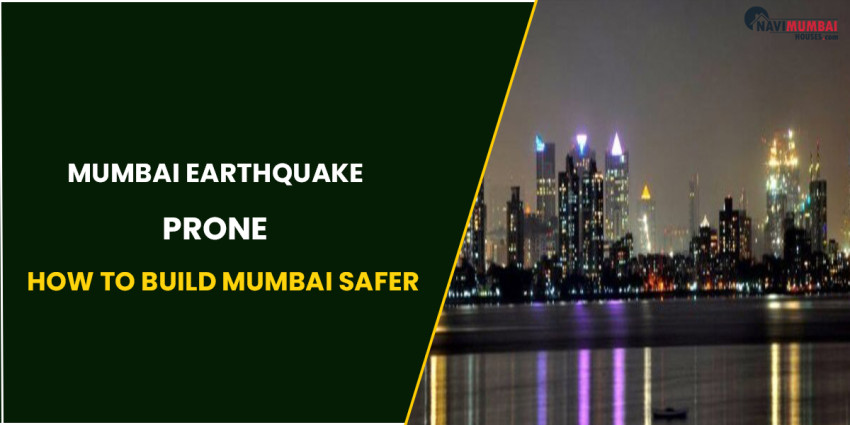
It is important to remember that an earthquake's intensity can vary significantly based on a variety of variables, including the location and depth of the epicentre as well as the local geological features. In addition, effective planning and building regulations can assist to reduce the damage brought on by seismic activity and lessen the effects of earthquakes.
Are you looking 2BHK flat for Rent in Navi Mumbai?
Mumbai, one of India's biggest and most populated cities, is situated in zone III, which is referred to as a "moderate risk" location on the seismic map. However, according to geological scientists, the area is substantially more susceptible to earthquakes because of an active fault line that runs through the earth's crust from Panvel to the north in Koparkhairne and Bhiwandi. This is because seismic activity may be caused by active fault lines, which are places where two tectonic plates collide and are prone to movement. Mumbai also has a higher danger of a tsunami because of its proximity to the shore.
Combining seismic and tsunami threats emphasises how crucial it is to take the appropriate safeguards to lessen the possible effects of natural catastrophes in the area. This entails bringing up-to-date construction codes to guarantee that buildings are constructed to resist seismic activity and frequently doing drills and evacuation exercises to get people ready for an emergency.
What Do Experts Say About Earthquakes in Mumbai?
Mumbai is deemed to be extremely sensitive to damage and loss of life due to the large population density in the city, even if it is categorized as a medium-risk location in terms of seismic activity, according to a study created by the National Disaster Management Authority (NDMA). According to the paper, the enormous number of people living near to one another and the fact that many of the city's structures and infrastructure are not built to resist seismic activity are the causes of this "high exposure."
The eastern suburbs of Mumbai, according to a previous research by the Indian Institute of Technology (IIT) Bombay, are highly earthquake-prone. According to the survey, the areas with the highest earthquake risk include Shivaji Nagar, Govandi, Ghatkopar, Bhandup, Powai, Vikhroli, Vidyavihar, and Mulund.
These regions are more vulnerable to seismic activity due to a combination of variables. For instance, despite the high population density in places like Shivaji Nagar, Govandi, and Ghatkopar, many of the structures there were not designed to resist earthquakes. Additionally, the soft soil of Powai, Vikhroli, Vidyavihar, and Mulund enhances the ground motion during earthquakes, making the buildings more susceptible.
Numerous geologists have forecasted difficulties for the city in the future. Records from V Subramanyam, a former professor at the Indian Institute of Technology (IIT), show that since 2008, the eastern bank of Thane Creek has experienced earthquakes with a Richter scale value of about 4. An earthquake with a Richter scale magnitude of 6.2 to 6.5 is anticipated to happen soon. Residents and civic leaders should be ready for such a situation. They should also take the required safety steps to reduce harm and fatalities.
India's Seismic Zoning Map and the Risk Level for Mumbai
During 25 earthquakes of magnitude 4 or higher have been reported in Mumbai over the course of the previous 400 years, giving the city a lengthy history of suffering earthquakes. Even though there were only 200,000 people living in the city at the time, one of the most destructive earthquakes happened back in 1618, killing an estimated 20,000 people. This emphasises the risk of disastrous results when seismic activity takes place in densely populated regions.
The nation of India has been divided into four seismic zones, designated as zones 2, 3, 4, and 5. This aids in comprehending a region's seismicity. The maximum degree of seismicity is related with zone 5, whereas the lowest level is associated with zone 2. Mumbai is located in zone 3, which is a region of moderate danger. However, the study found that the city is vulnerable to high exposure because of its dense population.
How Safe is Mumbai?
The skyline of Mumbai is increasingly dominated by big skyscrapers and high-rise constructions. A serious worry is the increase in tall buildings in metropolitan areas. In the case of a significant earthquake, it might experience immense destruction. Authorities must take action to reduce the possible dangers in light of this worry. In the case of a seismic event, the protection of people's lives and property comes first.
Professor V. Subramanyam advises setting a limit of 23 floors or 70 metres for construction heights. This could be a useful strategy for reducing the possibility of earthquake-related damage and fatalities. For evaluating the structural stability of structures against seismic shock, BMC lacks checks. This is a serious issue that requires attention.
A significant worry is the absence of a seismic stability evaluation during the construction phase. Structural engineers stress the significance of seismic examinations for all buildings. For these professionals, determining the structures' structural soundness is essential. It guarantees their ability to endure seismic forces.
In addition, he says it could be essential to evacuate hilly regions where quarrying has already been done, like Powai. To stop earthquakes from starting landslides is the goal.
Furthermore, there are other factors to consider besides only the big structures. Because of their flimsy construction, older buildings aren't able to endure seismic pressures. It is crucial that the local government do routine inspections. It is essential to retrofit older structures that cannot resist seismic pressures.
In the case of an earthquake, tall buildings and high-rise structures in the city provide a serious risk. Authorities and professionals must implement strong steps to prevent this risk. This involves restricting construction heights, carrying out routine inspections, and making improvements to existing structures.
What is the situation right now?
After the Gujarat earthquake, industry analysts say Mumbai's structures now adhere to higher standards. They believe that the city's construction sector employs cutting-edge technologies. To maintain building safety and structural integrity, it performs appropriate examinations. Structural engineers who research the stratum and soil carrying capability do these evaluations. This is an essential action. It guarantees that the structures are sturdy enough to resist earthquake forces.
Mumbai Earthquake Resilience Solutions
Like many other cities throughout the globe, Mumbai is susceptible to earthquakes. The city has the power to make decisions. All of their residents' safety must be guaranteed.
Making ensuring the construction of new structures complies with seismic regulations is a crucial step. This means that structures should be built to resist earthquake forces. The chance of collapse is reduced as a result.
Retrofitting older structures that don't adhere to contemporary seismic regulations is another option. This may entail fortifying a building's walls, foundation, and other structural components. It is hence more earthquake-resistant.
Creating disaster preparation strategies is a crucial next step. Plans for evacuating buildings and public areas might be part of this. Plans for responding to and recovering from emergencies may also be included.
Traditional Japanese pagoda architecture is an illustration of effective earthquake-resistant building. These buildings are designed to move on their own during an earthquake. When the tremors stop, they turn back to their vertical posture. Through the movement of the building, this form of construction enables the energy of the earthquake to be dispersed. It has no chance of being absorbed and does not have the capacity to harm. It's crucial to take building costs into account as well. This approach could be pricey.
What Should You Do If There Is an Earthquake?
Finally, it's critical to inform and alert the public to the hazards. In the case of an earthquake, people must be aware of what to do. In this, the following is possible:
• Hide in the corner of a room, beneath a table, or even under a bed to remain undetected.
• Avoid touching glass, windows, external doors, and walls since they might all fall (such as lighting fixtures or furniture).
• Stay in bed if you are there when the earthquake happens. Hold on and shield your head with a pillow unless you are below a huge, potentially unstable light fixture. In that case, proceed to the closest secure area.
• When evacuating, residents of high-rise buildings should take the stairs rather than the elevator.
• If a doorway is available and you are convinced it is a firmly supported, load-bearing entryway, only utilise it as a last resort.
• Keep indoors until it is secure to go outside and the shaking stops. According to studies, people within buildings typically suffer injuries when they attempt to escape or transfer to a different area of the structure.
• Be aware that things like the sprinklers or the fire alarms might go off or lose power.
An overview of the Mumbai Earthquakes
Mumbai, one of the largest and most populous cities in India, is located in seismic zone III, which is referred to be a site with "moderate risk." The locations with the greatest danger of earthquakes include Shivaji Nagar, Govandi, Ghatkopar, Bhandup, Powai, Vikhroli, Vidyavihar, and Mulund, according to studies. Big structures and high-rise developments are taking over Mumbai's skyline in growing numbers. The rise of towering structures in urban areas is a big concern.
It might sustain considerable damage in the case of an earthquake. The traditional Japanese pagoda design is an excellent illustration of an earthquake-resistant structure. These structures are built to sway independently during an earthquake. To lessen this risk, authorities and experts must take decisive action. This entails limiting the height of new building, conducting regular inspections, and enhancing older structures.
Source From:- navimumbaihouses






